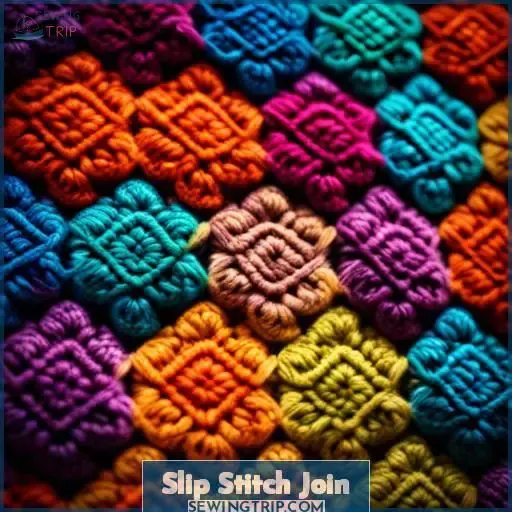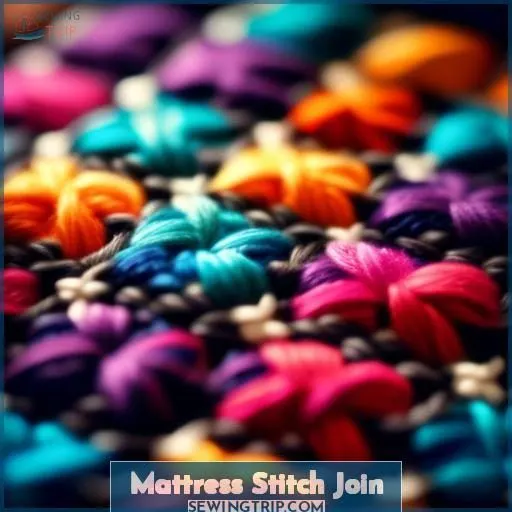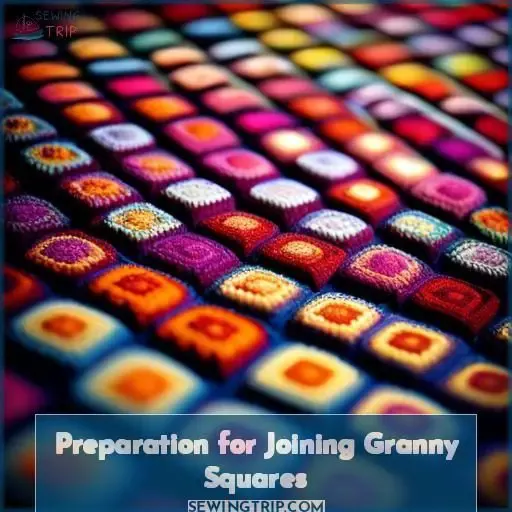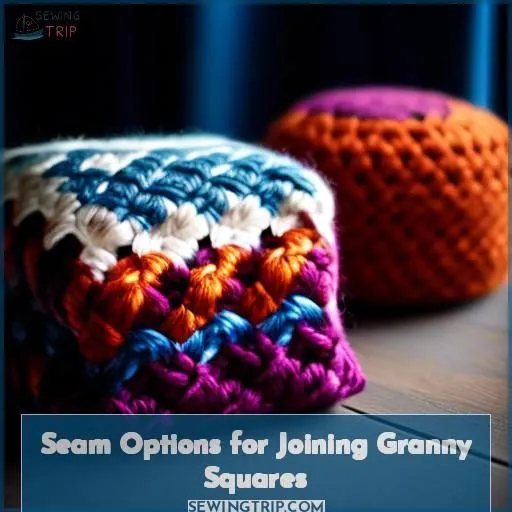This site is supported by our readers. We may earn a commission, at no cost to you, if you purchase through links.
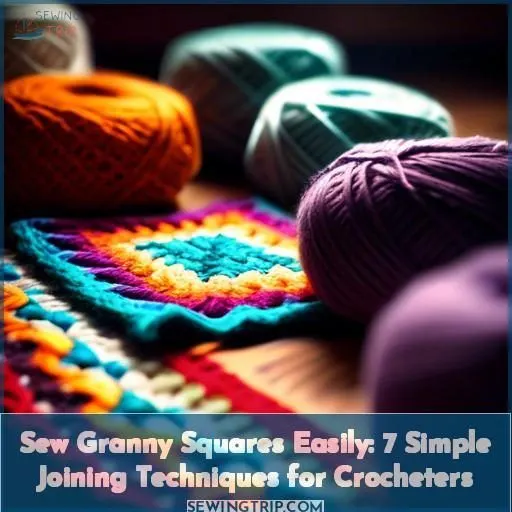
Sewing granny squares is a piece of cake with these seven simple joining techniques! For an invisible seam, try the Slip Stitch Join – just line up the wrong sides and slip stitch through the back loops.
The Flat Crochet Join is ideal for flat seams, with a slip stitch through the back loops.
Want a textured, rag quilt-inspired look? The Fringe Join is your way to go, with customizable fringes that complement your squares.
No matter your style, there’s a joining method to make your granny square projects gleam. Ready to delve deeper into the world of seamless granny square masterpieces?
Table Of Contents
Key Takeaways
- Choose the appropriate joining method based on the desired appearance, texture, and project requirements.
- Prepare your materials and motifs before joining, including blocking the motifs for equal size and stability.
- Maintain consistent tension and even stitches for a strong and seamless join.
- Consider the specific join method and its requirements, such as slip stitch placement for a balanced tension or the use of back loops for a flat seam.
How to Sew Granny Squares?
To sew granny squares, you can use various techniques, including the invisible seam, single crochet, reverse single crochet, slip stitch on the front side, slip stitch on the back side, and slip stitch and chain method.
The invisible seam, also known as the mattress or ladder stitch, is a popular choice for its neat finish on the front with sharp corners and barely noticeable stitches on the back.
Another option is the join as you go (JAYG) method, which involves attaching more granny squares to your join as you go.
Single Crochet Join
Ready to learn how to join your granny squares with a single crochet seam? This technique adds texture and strength to your project while creating a bulky seam that’s perfect for those who want a more pronounced join. Here’s a step-by-step guide:
- Prepare your materials: Make sure you have your crochet hook and the yarn you’ll be using for the seam.
- Choose your starting point: Begin at a corner where two motifs meet, typically a chain 3 or a joining chain.
- Attach the yarn: Insert your hook through both motifs in the last corner chain and attach your yarn, creating a slip knot.
- Chain 1: Chain 1 to create a foundation chain for your seam.
- Single crochet in the same stitch: Insert your hook through the back loop of the next stitch on the first motif and the back loop of the second motif, then single crochet in the same stitch.
- Continue stitching: Repeat this process, inserting your hook through the back loop of the next stitch on the first motif and the front loop of the second motif, single crocheting in each stitch.
Remember to keep your tension consistent and your stitches even to create a strong and seamless join. This technique is great for adding texture and strength to your project while also being easy to master. Happy crocheting!
Slip Stitch Join
Slip stitch join is a popular method for crocheters to seam their granny squares together. This join is quick and easy, creating an invisible seam that’s subtle and flexible. The slip stitch placement is important for achieving a balanced tension and an almost seamless join. To perform a slip stitch join, you’ll need to line up your motifs with the wrong sides facing each other. Insert your hook through the back loop of the first motif and the front loop of the second motif, then slip stitch in each stitch, keeping the tension loose for a flexible seam.
This join is suitable for various projects, including clothing and accessories. It’s particularly useful for creating a neat and tidy seam that isn’t visible on the right side of the work. The flat crochet join, on the other hand, is a different technique that involves working through the back loops only of your stitches, which results in a flat seam.
When joining granny squares, it’s vital to block the motifs beforehand to make sure they’re of equal size and stability. Check the stitch counts for alignment and lay out the squares for the desired arrangement. The choice of join depends on the desired appearance, texture, and project requirements. For a textured seam, use a single crochet join, while for a flat seam, use a flat crochet join.
Remember to keep your tension relaxed when using slip stitches to join squares, as working too tightly may cause the squares to not sit nicely once joined.
Flat Crochet Join
Ready to join your crochet squares? Here’s a simple technique for a flat crochet join. Start by inserting your hook on the right side of your squares, keeping the yarn under them. Slip stitch into the back loops of both motifs. Keep your tension loose for a flexible seam. This will give you a neat and tidy join that’s perfect for projects where you want a flat seam.
Practice makes perfect!
Mattress Stitch Join
After mastering the elegant simplicity of the Flat Crochet Join, let’s explore the realm of inconspicuous seams with the Mattress Stitch Join. This hidden gem among joining methods is your clandestine ally for crafting flawless masterpieces in your crochet endeavors.
Perfectly suited for garments where each stitch holds significance, the mattress stitch demands meticulousness but rewards with its ability to vanish. It’s akin to weaving an enchantment with yarn and hook, making your creations coalesce as if by sorcery.
Rag-Quilt-Style Join (Fringe Join)
Ready to add some texture to your granny square project? The Rag-Quilt-Style Join, also known as the Fringe Join, is just the trick! This technique is inspired by the classic rag quilt style and creates a highly textured seam.
To get started, choose a fringe length that suits your project and select a yarn that complements your squares. Decide on seam placement, considering whether you want a textured or flat seam.
For a unique touch, add decorative embellishments to your block shape. With a little practice, you’ll have a one-of-a-kind granny square that’s sure to impress!
Reverse Mattress Stitch Join
Ready to conceal the seams of your granny squares? The Reverse Mattress Stitch Join is your ultimate technique for practically seamless connections. This stitch excels for clothing and demands accuracy and attention to detail. It may seem daunting initially, but once you master it, you’ll become an expert sewer.
Preparing your squares is essential for a sturdy and aligned join. Block your motifs, verify your stitch counts, and arrange your squares as desired.
Now, let’s delve into the specifics of the Reverse Mattress Stitch Join. This stitch excels for clothing and demands accuracy and attention to detail. It may seem daunting initially, but once you master it, you’ll become an expert sewer.
Preparation for Joining Granny Squares
To guarantee a smooth and effective joining process for your granny squares, follow these steps:
- Block motifs: Prior to joining, block your motifs to guarantee they’re of equivalent size and stability. This will help maintain the overall look and quality of your project.
- Check stitch counts: Verify the stitch counts of each square to guarantee they align correctly. This will prevent any issues with stitch counts when joining.
- Lay out squares: Arrange your squares in the desired pattern before joining. This will help you visualize the final project and make any necessary adjustments.
- Seam preferences: Consider the desired appearance and texture of your project. Choose a join method that aligns with your preferences and project requirements.
Seam Options for Joining Granny Squares
Now that you’ve prepared your granny squares, it’s time to join them. Choose an invisible seam for a neat finish, a textured seam for added character, or a decorative seam for a unique touch. Remember, alignment issues can cause tension problems, so make sure your squares are evenly sized and lined up correctly. Keep these considerations in mind as you select the perfect join for your project.
Frequently Asked Questions (FAQs)
Can I join granny squares with different sizes?
Don’t let mismatched granny squares trip you up. Get crafty and flex your joining skills – just take a breath, review the techniques, and make those funky squares dance together seamlessly. You’ve got this!
How do I choose yarn color for joining?
Choosing yarn color for joining granny squares is like painting your walls – the whole shebang comes alive when you pick the right hue. Go bold, go subtle, or let your mood be your muse, honey. The world’s your crochet canvas!
What is the best join for a blanket?
The slip stitch join is the way to go for blankets, my friend. It’s a cinch to do, keeps things tidy, and lets the squares shine. Treat yourself to a cozy, cohesive blanket that’s a breeze to make!
How to join squares without crocheting or sewing?
You know, if you’re looking to join those squares without any needles or thread, why not try a little double-sided tape? Boom – instant connection, no fuss, no muss. Give it a whirl and see how it goes!
Are there joins that create a 3D effect?
Want a 3D pop? Try the Rag-Quilt-Style Join – it’ll add major texture and sass to your project. Just grab some fringe and get creative, my friend. Bring on the cozy, crafty vibes!
Conclusion
You’ve sewn, slipped, and fringed your way through granny square bliss – now it’s time to show off your granny square masterpieces! Whether you prefer a clean, seamless look or a cozy, rag quilt vibe, these seven simple joining techniques have got you covered.
So don’t be a square, get creative and let your granny squares shine. After all, variety is the spice of life, and these methods are the perfect recipe for making your projects truly one-of-a-kind.


